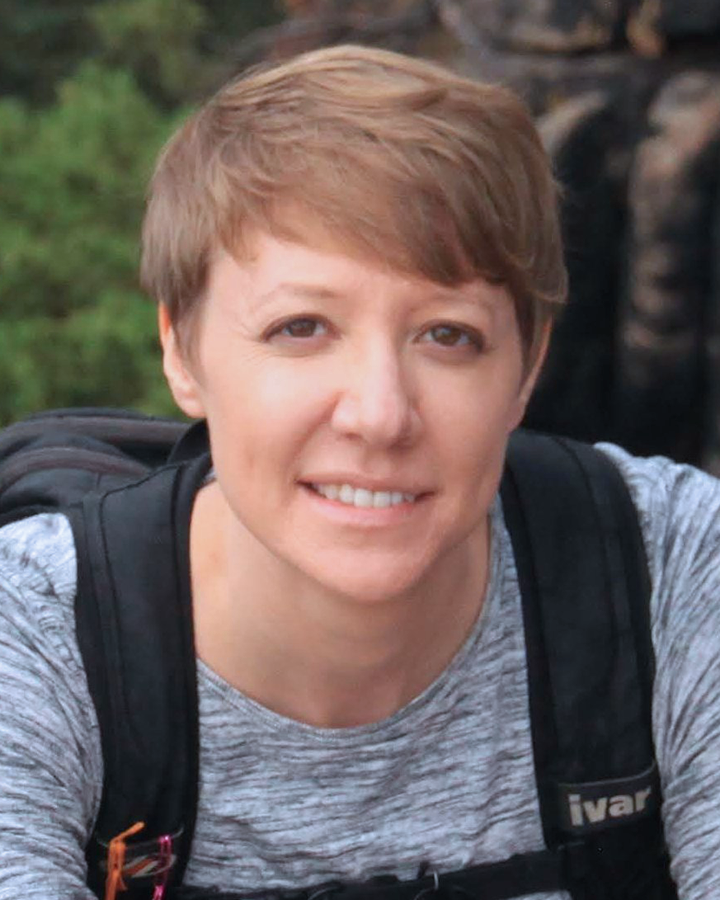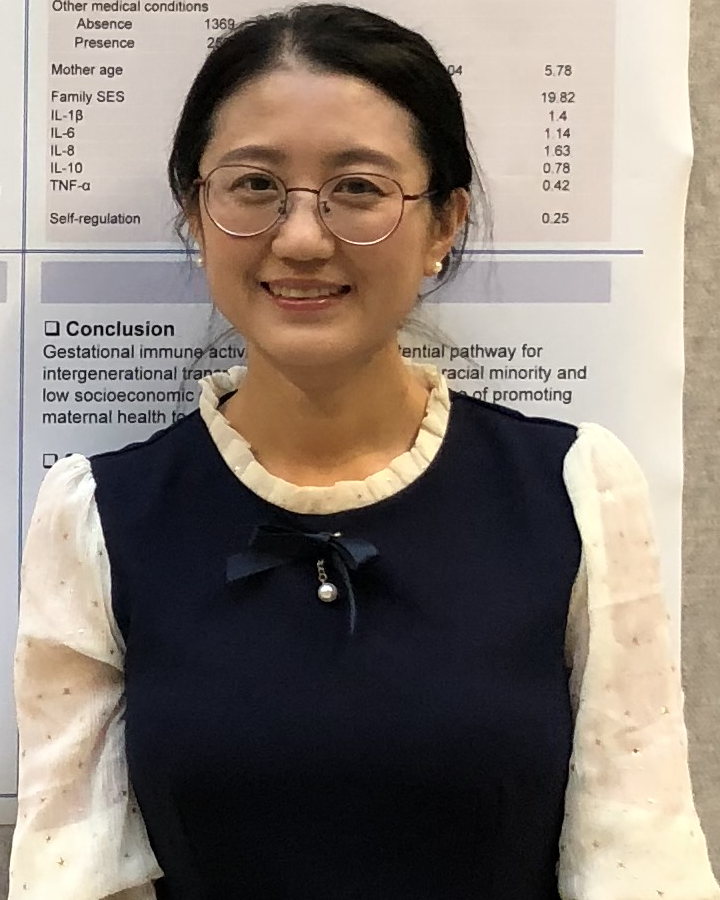
Katherine Rogers, PhD, Keynote Speaker
The lineup of investigators and trainees during the fully virtual NICHD DIR & DIPHR Scientific Retreat on November 5, 2021, showcases the institute’s commitment to its central vision: Healthy Pregnancies. Healthy Children. Healthy and Optimal Lives. Even under the weight of a global pandemic, the NICHD intramural program has generated impactful and exciting scientific research within a diverse set of topics. Indeed, a broad spectrum of ideas and expertise enables NICHD to foster the breadth of research needed to tackle the primary themes of the NICHD Strategic Plan. The essence of each theme (described within) was clearly on display at the retreat.
Beginning with the retreat’s keynote presentation by Katherine Rogers, PhD, principal investigator in the Unit on Developmental Signaling, several speakers touched upon the objectives laid out in the Strategic Plan’s first theme: Understanding the Molecular, Cellular, and Structural Basis of Development .
Dr. Rogers, who started her lab at NICHD in July 2021, develops tools and assays to better understand the formation of gene expression patterns in embryos. Her approach activates signaling pathways in zebrafish embryos in response to specific wavelengths of light, in a process known as molecular optogenetics. By controlling the amplitude of the light source, Dr. Rogers observes how varying levels of signaling differentially regulate gene expression.1 She can also probe the combinatorial effects of multiple signaling pathways by activating individual pathways with different wavelengths of light. These optogenetic tools lay the groundwork for many exciting new studies into the nature of embryonic gene expression and cellular differentiation.
Like Dr. Rogers, many NICHD researchers rely on animal models to understand the molecular and cellular basis of development, but researchers must also recognize the limitations of these models. Ramesh Chittajallu, PhD, a staff scientist from the McBain laboratory, seeks to understand whether the inhibitory neurons in mice, an animal model commonly used in neurobiological studies, function similarly to those in humans. Functional analyses show that a specific interneuron subtype in mouse and human fire at similar frequencies and have largely equivalent action potential waveforms, but how they behave following specific types of stimulation differs significantly between the two. Dr. Chittajallu emphasizes that this divergence—and the implications they have on using mouse models for neurological diseases—warrant further study.
Sometimes, the best place to probe for answers to clinically relevant questions is the human genome itself. Suvo Chatterjee, PhD, a postdoctoral fellow from the Tekola-Ayele lab, uses genome wide association studies (GWAS) to identify genetic loci associated with preterm birth. This genetic analysis relies on data from the NICHD Fetal Growth Study2 , a group of over 2,000 low-risk, ethnically diverse pregnant women from 12 US clinical sites. Dr. Chatterjee found that preterm birth is associated with eight loci in seven genes. In comparison to previous studies, only one of these loci was replicated among African and Hispanic women, whereas three loci were replicated among European women. These results emphasize the need for continued studies focusing on more diverse populations to generate reproducible and reliable data.

Ramesh Chittajallu, PhD

Suvo Chatterjee, PhD
The second theme emphasized in the NICHD Strategic Plan advocates for the Promotion of Gynecologic, Andrologic, and Reproductive Health. Several presentation topics touched on this theme, including female fertility following childhood cancer treatments, the influence of fibroids on newborn body measurements and preterm birth, and the effect of recreational activity on placental DNA methylation.
With increasing childhood cancer survival rates, about 400,000 cancer survivors reside in the United States3, but for many of them, radiation treatments or chemotherapy have damaged their reproductive organs. Jacqueline Maher, MD, staff clinician in the Gomez-Lobo lab, presented her work on understanding how cancer treatments during childhood and adolescence affect female fertility. She found that a childhood cancer survivor’s anti-Mullerian hormone (AMH) level—a marker of ovarian reserve—was associated with infertility risk, and the patient’s cancer type and treatment(s) gonadotoxicity level based on the Oncofertility Pediatric Initiative Network risk stratification system4 predicted their AMH levels. Surprisingly, Dr. Maher also observed that almost 10 percent of the women in the high-risk group for infertility did eventually become pregnant. These findings, based on a metaanalysis of 14 studies including over 600 patients’ individual data, emphasizes the complex nature of post-treatment counseling.
Another presenter to showcase research on gynecological health was Susanna Mitro, PhD, postdoctoral fellow from the Grantz laboratory, whose work reveals that fibroids (benign tumors that grow in the uterus) lead to larger neonatal head and arm circumference as well as a greater frequency of preterm birth. For her statistical analysis, Dr. Mitro used patient data from the NICHD Fetal Growth Study2 to investigate associations between the visualization of fibroids in ultrasounds taken at multiple points throughout the pregnancy and neonatal metrics. She categorized patients based on number of fibroids and fibroid size. According to Dr. Mitro’s analysis, the increased head circumference associated with fibroid observation appears to be unrelated to the risk of preterm birth.
Taking an epigenetic approach, Sifang (Kathy) Zhao, PhD, postdoctoral fellow who has worked with Drs. Yeung and Zhang in the Epidemiology Branch, presented her recent findings from an epigenome-wide association study on the correlation between maternal physical activity and placental DNA methylation. Using data from the NICHD Fetal Growth Study2 , she examined how the timing of physical activity relative to pregnancy affects epigenetic modification in the placenta. Using a questionnaire offered six times throughout pregnancy to a racially diverse population of pregnant women, Dr. Zhao found that physical activity associated with placental DNA methylation, which varied based on the timing of the physical activity. The largest change occurred at a site within TIMP2 , which encodes a protein involved in vasodilation, placentation, and uterine expansion during pregnancy. The finding suggests that lifestyle habits during pregnancy might influence the placenta through epigenetic modifications, a potential mechanism driving the intergenerational influence of physical activity.

Jacqueline Maher, MD

Susanna Mitro, PhD

Sifang (Kathy) Zhao, PhD
Like Dr. Zhao, multiple presenters at the retreat discussed studies with implications for improving pregnancy outcomes and maximizing the health of women and their children. This perfectly ties in with the third theme communicated in the Strategic Plan: Setting the Foundation for Healthy Pregnancies and Lifelong Wellness.
Ruijin Lu, PhD, postdoctoral fellow from the Chen lab, seeks to understand how neonatal outcomes, such as birthweight and birth length, associate with longitudinal lipid profiles from patient blood samples. In her presentation, Dr. Lu focused on the use of statistical analysis to identify specific lipid groups that most relate to neonatal outcomes. She presented her ongoing efforts to develop an algorithm that uses data that is longitudinal, high-dimensional (simultaneously analyzing more than 300 metabolites) and compositional (reliant on the relative abundance of what’s measured). Though this study is still ongoing, Dr. Lu and her colleagues have conducted multiple simulations to test their longitudinal method and have found that their algorithm gained more sparsity and higher accuracy in prediction on both simulated data and real data compared to currently available cross-sectional methods.
Jumping from computer models to animal models, Maziar Rahmani, MD, PhD, ABIM, clinical fellow in the Weinstein lab, uses genome-wide RNA profiling in zebrafish to investigate why diabetic individuals exhibit complications of diabetes many years after blood sugar levels have been brought under control—a phenomenon known as “glycemic memory.” Dr. Rahmani temporarily exposed zebrafish to hyperglycemic conditions and then periodically analyzed their liver tissue and liver endothelial cells during hyperglycemic and normoglycemic states to identify signaling pathways associated with glycemic memory. He discovered changes in multiple circadian clock genes in vascular endothelial cells. Dr. Rahmani believes his work has implications for understanding the pathogenesis of diabetic vasculopathy, a life-threatening condition.
Continuing with the theme of disease and lifelong wellness, Tushar P. Patel, PhD, postdoctoral fellow in the Yanovski lab, focuses his efforts on discerning the role of the melanocortin 3 receptor (MC3R) in metabolism and obesity. Specifically, he asked if MC3R signaling regulates hepatic lipid autophagy (the degradation of liver lipid droplets), given that lipogenic genes are upregulated in mice lacking MC3R.5 Dr. Patel observed an accumulation of light chain 3 (LC3) II, a classical marker for autophagy, upon activation of MC3R but not further increased LC3II activation in MC3R knockout, which instead caused decreased clearance of lipid droplets and excessive accumulation of autophagosomes. Additionally, he found that a loss of MC3R blocked autophagic degradation and interfered with autophagosome formation. Digging deeper, Dr. Patel discovered that MC3R might play a role in nuclear translocation of TFEB, a transcription factor linked to lysosomal biogenesis. Altogether, Dr. Patel’s research provides compelling evidence that MC3R is required for autophagosome formation in the liver, which has implications for understanding the molecular underpinnings of obesity.

Ruijin Lu, PhD

Maziar Rahmani, MD, PhD, ABIM

Tushar P. Patel, PhD
Two talks in particular highlight the fourth theme of the Strategic Plan, which underlines the institute’s commitment to Improving Child and Adolescent Health and the Transition to Adulthood. Jing Yu, PhD, research fellow in the Gilman lab, examines the effects of adverse childhood experience (ACEs) on premature mortality, and Morie Ishida, PhD, postdoctoral fellow in the Bonifacino lab, studies the impact of genetic mutations on neurological disorders in pediatric patients.
Dr. Yu wanted to know if adverse childhood experiences (ACEs), such as parental harshness and neglect, mental illness, divorce, crowded housing, and poverty, might contribute to the underlying causes of racial and socioeconomic disparities in premature mortality. Using data from the National Collaborative Perinatal Project6 and the National Death Index, she indeed found that children’s race and social class linked to their number of ACEs, and a greater number of ACEs correlated with a higher incidence of premature mortality. Dr. Yu speculates that the impact of ACEs on premature mortality could be explained by lasting biological impacts, such as physiological dysregulation of stress leading to chronic illness later in life, as well as factors that undermine healthy behavioral development.
Dr. Yu was immediately followed by Dr. Ishida, who investigates the impact of ARF1 gene mutations on neurological disorders in pediatric patients. The ARF1 protein is a small GTPase that regulates retro- and anterograde sorting and helps maintain the structure of the Golgi apparatus. To understand how the ARF1 mutations observed in pediatric patients contribute to individual neurological disorders, Dr. Ishida compared the effect of these mutations with those of known constitutively active and inactive versions of the ARF1 protein. He examined a variety of key functions, including the ability to interact with binding partners and to maintain the structure of the Golgi apparatus. Dr. Ishida found that all patient derived ARF1 mutations are likely to be gain of function mutations which are constitutively active. Interestingly, the patient-derived mutation that conferred the highest amount of activity linked to lysosomal abnormalities in fibroblasts taken from that patient.

Jing Yu, PhD

Morie Ishida, PhD
The remaining retreat presentations transition from human development and reproduction to a focus on our understanding of viral infections and disease. These presentations create a foundation for safe and effective anti-viral treatments for the broader public, linking them to the fifth and final theme of the Strategic Plan, Advancing Safe and Effective Therapeutics and Devices for Pregnant and Lactating Women, Children, and People with Disabilities.
The first of these talks was delivered by Leonid Margolis, PhD, senior investigator of the Section on Intercellular Interactions. Dr. Margolis presented his research into the underlying mechanisms of persistent immune activation, even in the absence of viral replication, within HIV-1 infected tissue. The question posed by this research is important because, even though modern antiretroviral therapies can inhibit viral replication in the human body below detectable levels, inflammation caused by persistent immune activation can lead to many adverse outcomes, such as cardiovascular disease and cancer. To understand the presence of immune activation despite the absence of viral replication, Dr. Margolis’ group systematically tested reasonable hypotheses until his group found that immune activation is supported by extracellular vesicles carrying HIV-1 molecules. Dr. Margolis believes that characterization of these extracellular vesicles may create a new target for therapy.
SARS-CoV-2, the etiological agent behind the COVID-19 pandemic, is a virus with imminent worldwide importance. Robbins Puthenveetil, PhD, a postdoctoral fellow in the Banerjee lab, presented novel findings7 that a post-translational modification called palmitoylation of the SARS-CoV-2 spike protein enhances its infectivity. Dr. Puthenveetil found that spike protein palmitoylation, which involves the attachment of a fatty acid moiety to a cytosolically exposed cysteine residue, predominantly occurs on a cluster of sites located near the transmembrane domain. He also identified multiple specialized enzyme DHHC-palmitoyltransferases that modify these sites to varying degrees. SARS-CoV-2 infectivity was greatly diminished when Dr. Puthenveetil removed the palmitoylation sites via mutagenesis, emphasizing the importance of this modification in the overall viral life cycle.

Leonid Margolis, PhD

Robbins Puthenveetil, PhD
During the closing remarks at the retreat, NICHD Postdoctoral Fellow Representative Lauren Walling, PhD, thanked both the attendees and the presenters for making this year’s retreat a success. In particular, she described the experience as “a great opportunity to learn about some of the outstanding and diverse research that’s going on within our institute.” Undoubtably, the capacity to maintain a commitment to the specific set of goals laid out in the NICHD Strategic Plan, while also facilitating impactful research on such a diverse spectrum of topics, is one of the NICHD’s greatest assets.
References
- Rogers KW, ElGamacy M, Jordan BM, Muller P. (2020). “Optogenetic investigation of BMP target gene expression diversity.” Elife. 9:e58641. doi: 10.7554/eLife.58641.
- “Epidemiology Branch Research: NICHD Fetal Growth Study.” Eunice Kennedy Shriver National Institute of Child Health and Human Development. January 4, 2022. https://www.nichd.nih.gov/about/org/dir/dph/officebranch/eb/fetal-growth-study.
- Howlader N, Noone AM, Krapcho M, et al. (eds). SEER Cancer Statistics Review, 1975–2018, National Cancer Institute. Bethesda, MD, https://seer.cancer.gov/csr/1975_2018/, based on November 2020 SEER data submission, posted to the SEER web site, April 2021.
- Meacham LR, Burns K, Orwig KE, Levine J. (2020). “Standardizing Risk Assessment for Treatment-Related Gonadal Insufficiency and Infertility in Childhood Adolescent and Young Adult Cancer: The Pediatric Initiative Network Risk Stratification System.” J Adolesc Young Adult Oncol. 9(6):662-666. doi: 10.1089/jayao.2020.0012.
- Lee B, Koo J, Yun Jun J, Gavrilova O, Lee Y, Seo AY, Taylor-Douglas DC, Adler-Wailes DC, Chen F, Gardner R, Koutzoumis D, Kazemzadeh RS, Roberson RB, Yanovski. (2016). “A mouse model for a partially inactive obesity-associated human MC3R variant.” Nat Commun. 7:10522. doi: 10.1038/ncomms10522.
- Niswander KR, Gordon M. (1972). “The Collaborative Perinatal Study of the National Institute of Neurological Diseases and Stroke: The Women and Their Pregnancies.” W.B. Saunders Company; Philadelphia: 1–19.
- Puthenveetil R, Lun CM, Murphy RE, Healy LB, Vilmen G, Christenson ET, Free EO, Banerjee A. (2021). “S-acylation of SARS-CoV-2 spike protein: Mechanistic dissection, in vitro reconstitution and role in viral infectivity.” J Biol Chem. 297(4):101112. doi: 10.1016/j.jbc.2021.101112.
